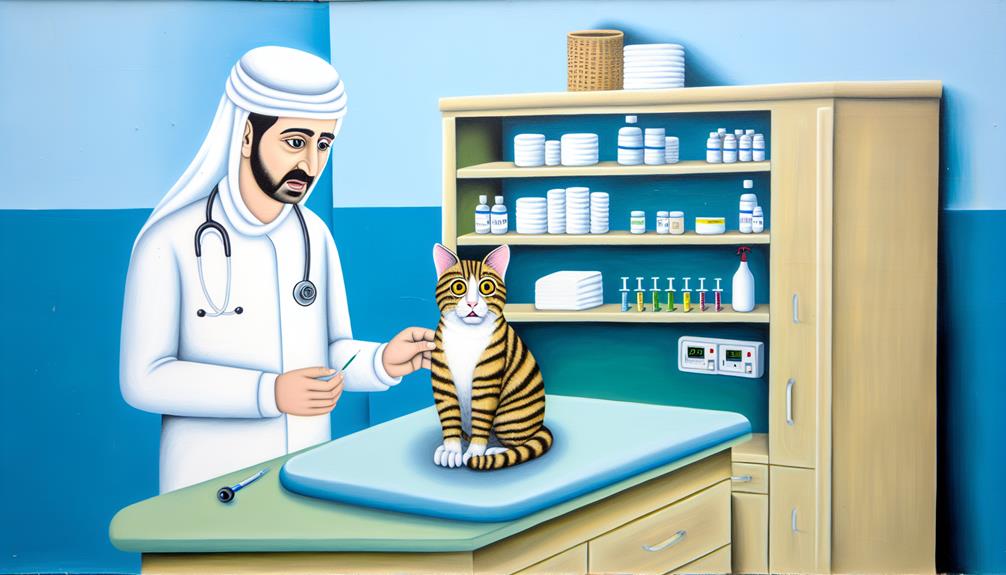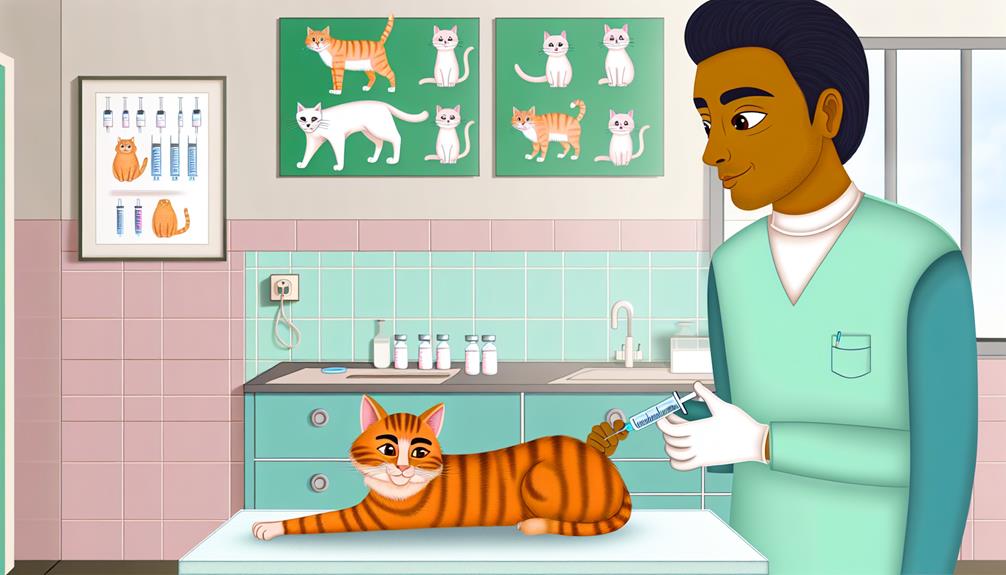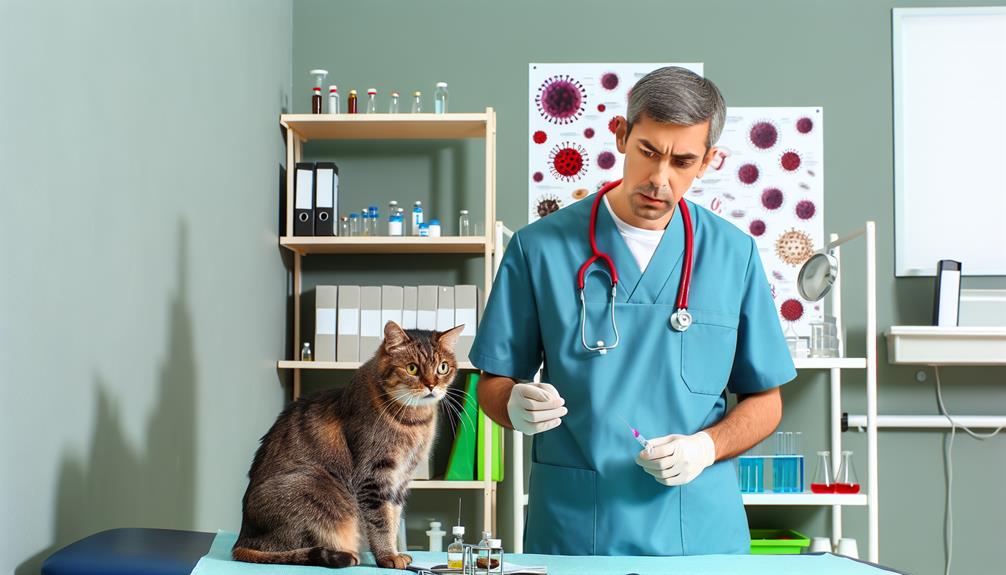It's quite the coincidence that you're asking about parvo in cats just as I was researching the topic myself. You might think parvovirus only affects dogs, but cats can actually get a similar infection called feline parvovirus (FPV), leading to a condition known as feline panleukopenia. This virus is highly contagious and can have severe consequences for your feline friend. With symptoms like gastrointestinal distress and lethargy, it's important to understand how this virus operates and the steps you can take to protect your cat. Curious about the key preventive measures and treatments? Let's explore further.
Understanding Feline Parvovirus
Although many pet owners are familiar with canine parvovirus, it's important to understand that a similar virus, known as feline panleukopenia virus (FPV), poses a considerable threat to cats. FPV, also referred to as feline parvovirus, is a highly contagious viral infection that can lead to severe health complications in felines. This virus primarily targets rapidly dividing cells, such as those found in the intestinal lining, bone marrow, and lymphoid tissues.
In terms of feline health, FPV is particularly dangerous due to its capacity to induce acute symptoms. Clinical manifestations often include high fever, lethargy, vomiting, diarrhea, and severe dehydration. The virus's impact on the bone marrow leads to a drastic reduction in white blood cells (leukopenia), compromising the immune system and making the cat susceptible to secondary infections.
FPV is a member of the Parvoviridae family and shares structural similarities with canine parvovirus. However, it's uniquely adapted to infect cats. The pathogenesis of FPV involves initial replication in the oropharyngeal lymphoid tissue, followed by systemic dissemination through the bloodstream. The rapid viral replication results in extensive tissue damage, particularly in the gastrointestinal tract, leading to hemorrhagic enteritis.
Evidence-based studies have shown that timely vaccination is critical for preventing FPV infections. Vaccines stimulate an immune response that provides long-term immunity, greatly reducing the incidence of the disease. It's also important to maintain a clean environment to minimize exposure to viral particles, which can persist in the environment for extended periods.
Understanding the severity and clinical implications of FPV helps underscore the importance of preventive measures in maintaining ideal feline health. Regular veterinary check-ups and adherence to vaccination schedules are necessary to safeguard against this formidable viral infection.
Transmission and Risk Factors
Understanding the severity and clinical implications of FPV underscores the importance of discussing how this virus spreads and the factors that elevate the risk of infection. Feline Panleukopenia Virus (FPV) is highly contagious and can be transmitted through various routes, making it a considerable threat to unvaccinated cats.
The primary transmission route for FPV is through direct contact with infected cats or their secretions, such as saliva, urine, and feces. Indirect transmission can also occur via contaminated environments, including bedding, food dishes, and litter boxes. The virus is remarkably stable in the environment, capable of persisting for months, which heightens the risk of exposure. Consequently, even indoor cats aren't entirely safe if the virus is inadvertently brought in on shoes or clothing.
Several risk factors can elevate a cat's susceptibility to FPV. The most prominent is the lack of vaccination. Unvaccinated kittens are particularly vulnerable due to their immature immune systems. Another considerable risk factor is overcrowding, commonly seen in shelters and catteries, which facilitates rapid virus spread. Additionally, stress and poor nutrition can compromise a cat's immune response, increasing the likelihood of infection.
Understanding these transmission routes and risk factors helps in implementing effective preventive measures. Vaccination remains the cornerstone of FPV prevention, considerably reducing the risk of infection. Maintaining a clean environment, minimizing stress, and ensuring proper nutrition are also critical steps you can take to protect your cat. By staying informed and vigilant, you can considerably reduce the chances of FPV affecting your feline friend.
Symptoms of Feline Parvo

When observing for feline parvo, you'll notice initial signs such as lethargy, anorexia, and a sudden onset of vomiting and diarrhea. These symptoms can rapidly escalate, leading to severe dehydration, electrolyte imbalances, and potentially fatal complications. Immediate veterinary intervention is essential to mitigate the virus's severe health impacts.
Recognizing Initial Signs
Early detection of feline parvovirus (FPV) is essential for effective treatment and management. Recognizing initial signs can notably impact your cat's health outcomes. Symptoms often manifest subtly at first, affecting cat behavior and overall feline health.
Common early symptoms of FPV include lethargy, loss of appetite, and sudden onset of fever. You might also notice your cat exhibiting vomiting and diarrhea, which can rapidly lead to dehydration. Observing these initial signs promptly is vital for timely veterinary intervention.
Here's a table summarizing the early symptoms to watch for:
| Symptom | Description |
|---|---|
| Lethargy | Reduced energy levels, inactivity, reluctance to move |
| Loss of Appetite | Decreased interest in food, refusing meals |
| Fever | Elevated body temperature, often above 103°F (39.4°C) |
| Vomiting | Frequent expulsion of stomach contents, often foamy |
Cats with FPV may also exhibit changes in their grooming habits and social behavior. They might hide more often or become less interactive. It's important to closely monitor these changes and seek veterinary care if your cat displays any of these symptoms. Early intervention can greatly improve the prognosis and help manage the disease more effectively.
Severe Health Impacts
Experiencing severe health impacts from feline parvovirus (FPV) can be distressing for both you and your cat. The virus primarily targets rapidly dividing cells, leading to severe gastrointestinal and hematological symptoms. Clinically, you might observe profuse vomiting, hemorrhagic diarrhea, and profound lethargy. These manifestations can cause rapid dehydration and significant weight loss, requiring immediate veterinary intervention.
FPV also compromises the immune system by attacking bone marrow and lymphoid tissues, resulting in leukopenia. This reduction in white blood cells can make your cat highly susceptible to secondary infections. Dietary considerations become paramount during recovery; your veterinarian may recommend a bland, easily digestible diet to minimize gastrointestinal distress.
Long-term effects of FPV can be severe. Kittens, particularly those infected in utero or within the first few weeks of life, might suffer from cerebellar hypoplasia, leading to lifelong coordination issues. Additionally, chronic gastrointestinal problems may persist, requiring ongoing dietary management and regular veterinary check-ups.
Understanding these severe health impacts underscores the importance of timely vaccination and booster shots. Regular veterinary visits guarantee early detection and management, potentially mitigating the virus's long-term effects and improving your cat's quality of life.
Diagnosis and Testing
Diagnosing parvovirus infection in cats involves a combination of clinical evaluation, laboratory testing, and sometimes imaging studies. Initially, your veterinarian will perform a thorough clinical examination to identify symptoms such as lethargy, vomiting, diarrhea, and fever. These signs can be indicative of various diseases, so a differential diagnosis is necessary to rule out other conditions like panleukopenia, feline leukemia virus (FeLV), or feline immunodeficiency virus (FIV).
Laboratory testing is a critical step in confirming a parvovirus infection. Blood tests, particularly a complete blood count (CBC), often reveal a marked decrease in white blood cells, a common finding in viral infections. Biochemical profiles may show dehydration, electrolyte imbalances, or liver enzyme abnormalities. Fecal examinations through polymerase chain reaction (PCR) tests or enzyme-linked immunosorbent assays (ELISA) are highly sensitive methods used to detect viral DNA in stool samples, providing definitive evidence of parvovirus.
In certain cases, imaging studies like abdominal X-rays or ultrasounds might be necessary. These can help identify complications such as intestinal obstruction or secondary infections, which can arise due to the immunosuppressive effects of the virus. While not always required, these imaging techniques can provide a more complete picture of the cat's health status and guide further treatment decisions.
It's essential to understand that early detection and prompt diagnosis greatly improve the prognosis for cats with parvovirus. Ensuring that your veterinarian employs a thorough diagnostic approach, including differential diagnosis and advanced laboratory testing, can make a significant difference in outcome. Regular veterinary check-ups and prompt attention to symptoms will help safeguard your feline friend's health.
Treatment Options

When treating a cat with parvo, your veterinarian will likely prescribe antiviral medications and antibiotics to prevent secondary infections. Supportive care strategies, such as fluid therapy and nutritional support, are essential for stabilizing your cat's condition. At home, you'll need to follow strict hygiene protocols and provide a stress-free environment to aid recovery.
Veterinary Medication Choices
Treatment options for feline parvovirus, although somewhat limited, include several vital veterinary medications designed to manage symptoms and support recovery. Antibiotic therapy is often employed to counteract secondary bacterial infections that may arise due to the immunocompromised state of the cat. Broad-spectrum antibiotics are commonly chosen to cover a wide range of potential pathogens.
Antiviral medications, while not specifically tailored for feline parvovirus, can sometimes be used off-label to reduce viral replication. These medications, however, are not always effective and should be discussed thoroughly with your veterinarian.
Hydration management is paramount in treating feline parvovirus. Intravenous fluids are typically administered to prevent dehydration and maintain electrolyte balance. This is essential as dehydration can exacerbate the severity of the disease.
For immune support, veterinarians may recommend immunoglobulin injections to help bolster the cat's immune system. Additionally, nutritional supplements are often suggested to guarantee the cat maintains adequate nutrition during the recovery phase.
Pain relief is another vital component, as it helps manage abdominal pain and discomfort associated with gastrointestinal symptoms. Nonsteroidal anti-inflammatory drugs (NSAIDs) or opioids may be used under strict veterinary supervision.
Supportive Care Strategies
Supportive care strategies for feline parvovirus play a vital role in aiding recovery and improving prognosis. Dehydration is a major concern, so implementing effective hydration techniques is essential. Intravenous fluid therapy is often the gold standard, as it guarantees rapid and precise rehydration, maintaining electrolyte balance. Subcutaneous fluids can be an alternative in less severe cases or when IV access is challenging.
Nutritional support is another cornerstone of care. High-protein, easily digestible diets can help maintain the cat's strength and immune function. Enteral nutrition via feeding tubes might be necessary if the cat is unable to eat independently. This guarantees the continuous delivery of essential nutrients and calories, preventing further debilitation.
Antiemetics are often employed to control vomiting, thereby enhancing the effectiveness of nutritional support and hydration. Additionally, broad-spectrum antibiotics can be administered to prevent secondary bacterial infections due to the immunosuppressive nature of the virus.
Temperature regulation is essential, as hypothermia can exacerbate the cat's condition. Providing a warm, comfortable environment can greatly impact recovery rates. By combining these evidence-based supportive care strategies, you can improve the chances of recovery for cats afflicted with feline parvovirus.
Home Care Guidelines
For effective home care of cats diagnosed with feline parvovirus, it is crucial to closely monitor their hydration status and nutritional intake. Guaranteeing adequate hydration can be achieved through hydration tips like providing fresh water frequently and using electrolyte solutions recommended by your veterinarian. Homemade diets tailored for sensitive stomachs can guarantee your cat receives necessary nutrients without exacerbating gastrointestinal symptoms.
Minimize stress factors by creating safe spaces where your cat feels secure, away from loud noises and other pets. Environmental cleanliness is paramount; regularly disinfect surfaces and wash bedding to reduce viral load and prevent secondary infections. Incorporate gentle grooming routines to maintain their coat and skin health, which can boost overall well-being.
Engage your cat with low-energy playtime activities and enrichment ideas to keep their mind stimulated without overly taxing their already compromised system. Puzzle feeders and interactive toys can provide mental stimulation without excessive physical exertion.
Prevention Strategies
Preventing feline parvovirus, also known as feline panleukopenia, involves a multifaceted approach grounded in evidence-based practices. To effectively shield your cat from this highly contagious and often fatal virus, consider integrating strategic dietary considerations and stringent hygiene practices into your routine.
Dietary Considerations
Ensuring your cat has a robust immune system is essential. A diet rich in high-quality proteins, essential fatty acids, and vitamins can greatly bolster their immune defenses. Avoid low-quality commercial foods laden with fillers and preservatives; instead, opt for nutritionally balanced diets. Always consult with a veterinarian to tailor a diet specific to your cat's needs, as individual requirements can vary.
Hygiene Practices
Maintaining an immaculate environment is vital. Feline parvovirus can persist in the environment for extended periods, making thorough sanitation paramount. Use disinfectants proven to eradicate parvovirus, such as bleach solutions, on all surfaces your cat frequently contacts.
Here's a quick reference table to help streamline your prevention strategies:
| Prevention Aspect | Key Actions |
|---|---|
| Dietary Considerations | High-quality proteins |
| Essential fatty acids | |
| Hygiene Practices | Regular disinfection |
| Clean litter boxes daily |
Isolation and Quarantine
If you introduce a new cat into your home, isolate them for at least two weeks to monitor for any signs of illness. This quarantine period allows you to protect your existing pets from potential exposure.
Incorporating these prevention strategies into your cat care routine will greatly reduce the risk of feline parvovirus infection. By focusing on dietary considerations and rigorous hygiene practices, you lay a solid foundation for your cat's health and wellbeing.
Vaccination Importance

Vaccination is a cornerstone in the fight against feline parvovirus, also known as feline panleukopenia. This highly contagious and potentially fatal viral disease can be effectively mitigated through timely and appropriate immunization. Making sure your cat receives vaccinations is not just a recommendation; it is a critical component of responsible pet ownership.
Vaccine effectiveness for feline panleukopenia is well-documented. The vaccines available today offer robust protection, greatly reducing the incidence of the disease. According to veterinary studies, the efficacy of these vaccines can reach up to 99%. This high level of protection underscores the importance of adhering to established immunization schedules.
Your veterinarian will typically recommend an initial series of vaccinations for kittens, starting as early as six to eight weeks of age. This initial series usually involves multiple doses spaced several weeks apart to guarantee the best immune response. Following the initial series, booster shots are essential to maintain immunity. These booster shots are generally administered annually or triennially, depending on the specific vaccine and your cat's health status.
Skipping or delaying vaccinations can leave your cat vulnerable to infection. Without proper immunization, the risk of contracting feline panleukopenia increases dramatically, which can lead to severe gastrointestinal symptoms, dehydration, and even death. As a result, you must adhere to the recommended immunization schedules and consult your veterinarian for any adjustments based on your cat's individual health needs.
Conclusion
You'd think cats, with their nine lives, would be invincible, but feline parvovirus proves otherwise. Unvaccinated cats, especially kittens, face high risks. Despite the virus's severe impact on the gastrointestinal tract and immune system, prevention is straightforward: vaccinate. It's ironic that something as simple as a vaccine can save lives in a world where so much is complicated. Don't wait for symptoms to appear; arm your feline friend with the best defense—vaccination.
